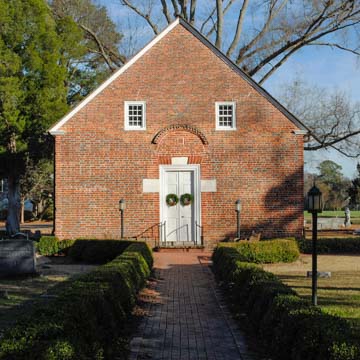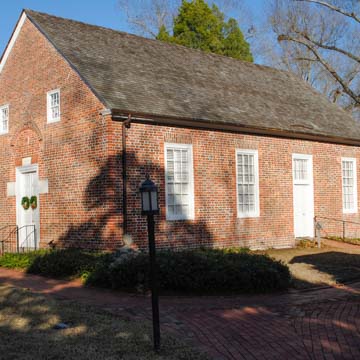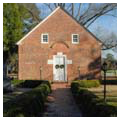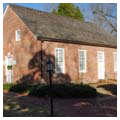You are here
St. Thomas Episcopal Church
St. Thomas Episcopal Church is the oldest surviving religious building in Bath, which was incorporated in 1705 and is acknowledged as North Carolina’s first town. St. Thomas Parish, established in 1696, predates the founding of the coastal town. Congregants initially met in one another’s houses for services. During the colonial era, the British Crown and, by extension, the Church of England, levied taxes to pay for the construction of churches, but in North Carolina, where the Church of England did not have a strong hold, many parishes did not have funds to build. Consequently, many churches were small and expeditiously and inexpensively built of wood. This brick edifice, then, constructed between 1734 and 1739, was a major achievement for its time.
St. Thomas Episcopal Church is located on the south side of Craven Street just west of the intersection with Harding Street. The building’s gable parallels a low stonewall that runs along Craven Street with the main entrance on the western gable end, facing a shrub-lined brick path and small graveyard. It is a simple, well-built church, 30 feet wide by 52 feet deep, nearly rectangular in plan. The exterior brick walls are two feet thick at the base and laid in Flemish bond with glazed-headers. A plain rectangular door headed by a flat (or jack) arch with a segmental arch above marks the main entrance at the western gable end. The north and south sides are four bays long and marked by large rectangular windows, except for the third bay on the south side, which is a door. The interior is a single-room plan with a west-end gallery accessed by a stair in the northwest corner and a simple altar to the east between two large rectangular windows. The church was heavily damaged by a storm in the mid-nineteenth century. What stands today is an early- to mid-twentieth-century restoration.
Although Bath became a trade center for naval stores, furs, and tobacco, the town and congregation remained small. St. Thomas was formally admitted to the Diocese of North Carolina in 1823. A Victorian restoration following storm damage in 1840 added new furniture and fixtures. In 1939 local architect Robert B. Davis, under the direction of Reverend A.C.D. Noe, restored the church building. St. Thomas Episcopal Church was listed on the National Register of Historic Places in 1970 and has remained in continual use for over 250 years.
References
Angley, Wilson. “St. Thomas Episcopal Church.” NCpedia. Accessed January 28, 2019. http://ncpedia.org/.
Bishir, Catherine W. North Carolina Architecture. Chapel Hill: University of North Carolina Press, 1990.
Bishir, Catherine W., and Michael T. Southern. A Guide to the Historic Architecture of Eastern North Carolina. Chapel Hill: University of North Carolina Press, 1996.
“History.” St. Thomas Episcopal Church. Accessed December 11, 2014. http://www.stthomasparishnc.org/.
North Carolina Historic Sites. “Historic Bath: St. Thomas Episcopal Church.” North Carolina Historic Sites, Division of North Carolina Department of Cultural Resources, Office of Archives & History. Last updated June 5, 2012. http://www.nchistoricsites.org/.
Zehmer, J.G., and John B. Wells, “St. Thomas Episcopal Church,” Beaufort County, North Carolina. National Register of Historic Places Inventory–Nomination Form, 1970. National Park Service, U.S. Department of the Interior, Washington, D.C.
Writing Credits
If SAH Archipedia has been useful to you, please consider supporting it.
SAH Archipedia tells the story of the United States through its buildings, landscapes, and cities. This freely available resource empowers the public with authoritative knowledge that deepens their understanding and appreciation of the built environment. But the Society of Architectural Historians, which created SAH Archipedia with University of Virginia Press, needs your support to maintain the high-caliber research, writing, photography, cartography, editing, design, and programming that make SAH Archipedia a trusted online resource available to all who value the history of place, heritage tourism, and learning.











